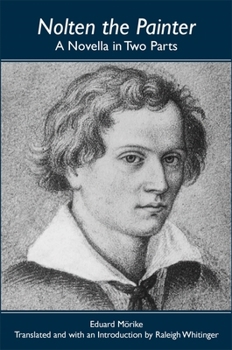Nolten the Painter: A Novella in Two Parts
(Part of the Studies in German Literature Linguistics and Culture Series)
When students and critics of the novel speak of German artist-novels and Bildungsromane, they mention works long available in translation: by Goethe, Novalis, Hoffmann, Stifter, Keller, or more recently by Mann, Kafka, Musil, Grass, and others. Yet Eduard M rike's provocatively subtitled Maler Nolten: Novelle in Zwei Teilen (Nolten the Painter: A Novella in Two Parts, 1832) has remained neglected and misunderstood, and has never been translated into English until now. This despite its obvious ties to other artist-novels and its striking modernity in playing with conventions of narrative authority and heroic identity, features that have recently begun to be realized by scholarship. Witness the subtle irony of the opening sequence, in which M rike's narrator is subverted by hints at his own clumsiness and intimations about the dire truths that lurk behind the protagonist's relationships to his male friends and to the seductive yet somehow frightening women in his life. Or the interplay between the narrator's attempts to make sense of Nolten's complex inner motivations in his loves and art and the ludicrously pompous pathos with which Nolten persists in speaking and thinking, as he concocts a heroic persona caught up in passion, intrigue, and tragedy. Fascinating, finally, is the mysterious trail of the "Grenzg nger," or border-line characters, such as the Gypsy Elisabeth, the queer Wispel, the duplicitous actor Larkens, and the mysterious old Hofrat, with their hints at the dimension of "Gypsies, Tramps, and Thieves" that seems to threaten and at the same time to foster the complex unfolding of the realities of life and art that defy Nolten's all-too-artful "mastery." Raleigh Whitinger is professor in the Department of Germanic Languages, University of Alberta.
Format:Hardcover
Language:English
ISBN:1571133127
ISBN13:9781571133120
Release Date:March 2005
Publisher:Camden House (NY)
Length:334 Pages
Weight:1.48 lbs.
Dimensions:1.2" x 6.3" x 9.3"
Customer Reviews
1 rating
Post-Romantic intricacy
Published by Thriftbooks.com User , 15 years ago
This (long) novella was originally published in 1832, as Romanticism was receding, but it shares many of the genre's characteristics. There are masked balls, Counts and Countesses, impostors, gypsies, wasting deaths.... Moerike deliberately chose to call Nolten a "painter" rather than an "artist" to keep matters on a more human scale, and art plays only a small role here. Moerike sets up a number of pairings: Nolten and another painter, the two women he has feelings for (even his desire to form a relationship with a Countess is mirrored by his fiance's half-formed desire for another man), an actor and a half-crazed "fishy man"--both of whom try to do Nolten good by impersonating him in different ways. This is both a Bildungsroman and a novel of Fate, and fate here takes the form of different kinds of balancing--whatever good someone tries to do is most often balanced by something negative that comes of the same act, so events have the inevitibility of tragedy. The translation preserves the archaic language of the period, but it isn't offsetting. The narrative, while disjoint (and suggesting at different times modern metafictionist writers and even Raymond Roussel in impossibly-detailed descriptions of art works), is surprisingly engaging. If you read it more than once, all the ties, pairings and balancing-out will be clearer. A very interesting book.






